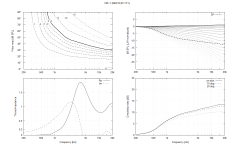Maybe this can be clustered in a multicell horn 🙂 with an ESP plug to fix the waveshape, and some of the other fixes to a multicell mentioned in Kolbrek's bookI do 🙂
View attachment 1192047
View attachment 1192045 View attachment 1192046
Obviously, these are impedance-optimized devices. I'm wondering what they can be good for... Probably not a high-fidelity reproduction. But maybe a garden - martens won't be pickey of what they get scared of 😛
I overlaid the discussed Horn(Red) and the Waveguide(Blue) DI...
Basically anywhere the DI is higher, will measure better, in room, in the sweet spot... Is that the general consensus?

Basically anywhere the DI is higher, will measure better, in room, in the sweet spot... Is that the general consensus?
But it is generally true, regardless, correct? A higher DI will result in a room measurement that is truer to the anechoic measurement, when speaking of the sweet spot.
All things else equal, the lower DI will cause more room reflections, than a situation of higher DI
All things else equal, the lower DI will cause more room reflections, than a situation of higher DI
That doesn't mean it measures better. That's not how should be speakers measured in the first place.A higher DI will result in a room measurement that is truer to the anechoic measurement, when speaking of the sweet spot.
You still completely overlook how flat that reflections are, spectrally (i.e. the slope of the DI). That's just not how it works.All things else equal, the lower DI will cause more room reflections, than a situation of higher DI
I didn't over look the phase and decay issues reflections cause. The more of the them, the more issues. The lower the DI the more reflective energyYou completely overlook how flat that reflections are, spectrally. That's just now how it works.
How flat are, room reflections?
All things else equal, I'm pretty sure it does mean it measures better, in a room.That doesn't mean it measures better. That's not how should be speakers measured in the first place.
But that's just not true. Come on. Anechoic chamber is really not a target for enjoyable listening environment. It would be if what you said was true.The more of the them, the more issues.
Yeah but Mabat you are talking preference, I am just talking about looking at measurements objectively. Even at high DI, the results are no where as accurate as the room performance of an Anechoic chamber. Using Room treatment, makes resulting measurements closer to the anechoic measurements as well..... The purpose of a Waveguide is to increase directivity, otherwise, no use of a waveguide.
Not necessarily, there are pretty wide-radiating (lowish DI) waveguides as well. It's mainly to maintain it controlled, so the reflections retain a similar spectral content as the direct sound.The purpose of a Waveguide is to increase directivity
And to measure such device properly, you ideally need an anechoic chamber, or another technique that eliminates reflections. Measuring it in a sweet spot including a room is just dilettantism.
Last edited:
So a flat baffled tweeter.... cannot have as good off axis performance as a waveguided tweeter?
No it can't, not nearly as close to what's possible with a waveguide.
https://www.diyaudio.com/community/...-design-the-easy-way-ath4.338806/post-7354055
https://www.diyaudio.com/community/...-design-the-easy-way-ath4.338806/post-7354055
I am curious what the best designed flat baffle polar looks like...compared to a waveguide of the same width.
I would suspect that less interaction at the baffle edge is apart of the reason why.... So basically just increased DI, makes the non flat waveguide better.
So basically just increased DI
No, just look at the example above - the waveguide actually decreases the DI at high frequencies compared to a raw tweeter in a baffle. It doesn't have to do it but it can, keeping the DI flat - that is its main function, to keep DI flat, as with any other good waveguide.
And I'm talking about the whole frequency band radiated by the device, whatever it is. Seems important to me, but that's the preference thing I guess 🙂
- Home
- Loudspeakers
- Multi-Way
- Acoustic Horn Design – The Easy Way (Ath4)
